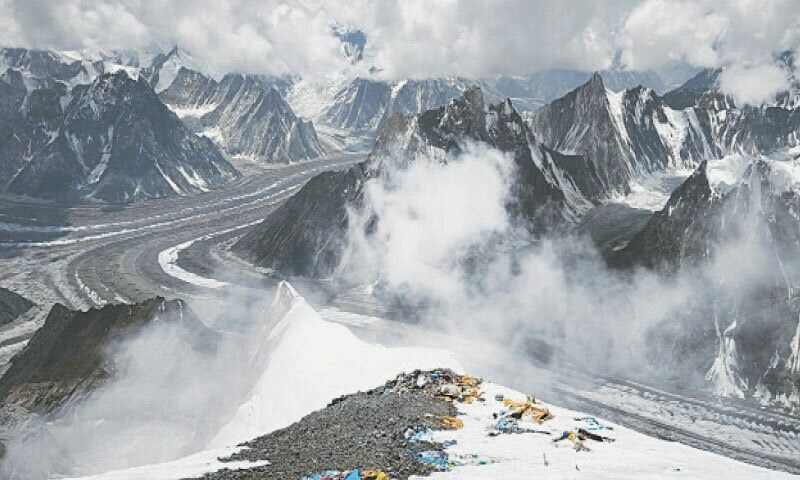
• Glaciers visibly receding; peaks more prone to avalanches; high temps, lack of snow making rockfalls more common
• Season comes to a close with climbers returning from K2, Broad Peak ‘empty handed’
FOR mountaineers, the mighty peaks in Gilgit-Baltistan’s Karakoram range became unusually precarious this year due to changing weather patterns, which have brought with them an increase in avalanches, rockfalls and other life-threatening hazards.
The mountains are comparatively dry, having lost much snow cover, and hence prone to avalanches — sometimes several times a day.
Baqir Ali, a mountain guide with four decades of experience, said he had never experienced such conditions on the peaks in his entire career.
A resident of Shigar’s Askole village, Mr Ali was part of Laura Dahlmeier’s team. The German Olympian recently perished after being struck by a rockfall at Laila Peak (6,096m).
“Several days before the incident, a French expedition team had cancelled their plan to attempt to climb Laila Peak due to the unfavourable weather conditions at the peak,” the 56-year-old told Dawn.
He said he had asked the German climber to do the same, but she continued her ascent in the alpine style — and at an altitude of 5,700m, she became the victim of falling rocks on July 28.
These precarious conditions made Hungary’s László Csomor abandon his expedition to Broad Peak (8,050 m) after more than a month and return to Skardu on Saturday.
His seven-member team had been at the base camp since June 27, hoping to summit the mountain. They, however, decided to call off the adventure, like more than two hundred climbers who had come to Pakistan to ascend its mighty peaks.
“This year, there was less snow at all mountains; rockfall was unusual; we would hear the sound of rockfall and snow avalanches 10 times in a day while sitting at the base camp,” László said, adding that he climbed to Camp 3 twice, but could not start the summit push due to bad weather. He blamed these conditions on less snow cover, saying that with enough snow, such threats diminish.
He said more than 90 climbers had been waiting at the base camp to summit K-2, while 30 mountaineers had been waiting to begin the Broad Peak adventure for the last month. Both peaks share the same base camp. Most of them have had to return with heavy hearts, as the climbing season for the Karakoram peaks nears its end.
László was also a witness to two accidents during his stay at the base camp – on July 11, Polish climber Waldemar Kowalewski fractured his leg in an avalanche on Broad Peak at 6,500m; while on July 19, porter Iftikhar Sadpara lost his life in a similar incident on K2’s Camp 1, located 500m above the base camp.
At least three people were killed and five were injured in such incidents during this season.
New challenges
“These conditions at the Karakoram range were new, and it was also challenging to climb the peaks because the snow was steep and unstable,” László said, adding that a decrease in snowfall made the slopes and hanging rocks prone to falls and avalanches, while crevasses had become bigger.
High winds also made the climb difficult. The foreign climber believed these changes were linked to climate change.
Mingma G, owner of Imagine Nepal and a renowned climber, also abandoned his Gasherbrum-II summit attempt due to avalanche risks. Traditionally, the climbing season for these peaks spans late June to mid-August. But this year, the risks are unusually high, forcing scores to abandon their summits.
“The weather at the peaks is not normal this year,” said Iqbal Qadri, a tour operator. Mr Qadri told Dawn that K2, Broad Peak, Gasherbrum-II and many other seven-thousanders remained unclimbed in the summer, while a few summits at Gasherbrum-I and Nanga Parbat were recorded.
He said some climbers were still at the K2 base camp, to try their luck. However, the season is over and this summer, none of the climbers could move past Camp 3 on K2.
This year, about 22 climbers, including five Pakistanis, scaled Gasherbrum-I (8,080 m) on July 20 and July 22, whereas at least 24 mountaineers, including foreigners, summited Nanga Parbat (8,126m) in the Himalayas.
Distressing situation
Veteran Russian climber Denis Urubko and his wife Maria Cardell summitted Nanga Parbat in alpine style while also charting a new route for ascent in July. Currently, he is in Skardu and plans to scale K2 via a new route. However, he said the situation in the mountains was distressing.
“Glaciers and snow on mountains are melting fast, crevasses are becoming larger, and rockfall occurrences have become routine in the GB mountains,” Mr Urubko said.
He said the “classical route” to summit Nanga Parbat had also become a dangerous route due to speedy snowmelt, adding that these factors had made risks in the mountains higher than usual.
A senior government expert blamed these conditions on changes in the snowfall patterns induced by global warming. He said the region received snow late in the year, and it could not be converted into ice before the summer and thus remained unstable. In addition to that, the heatwave in June and July exacerbated the situation, leading to an unusual number of avalanches.
Livelihoods in danger
As mountains become precarious for climbers, the livelihoods of those who are linked to the tourism industry have also taken a hit. Out of 400 applications received by the GB tourism department, only over 200 climbers from multiple countries arrived to attempt summits, almost 50 per cent down from the previous year.
Thousands of people, including transporters, shopkeepers, hotel owners, porters, mountain guides, and tour operators, depend on the industry for income. Fida Hussain, a high-altitude porter from Shigar, feared that with the reduction of adventure tourism activities, they would also be left without jobs and income.
Published in Dawn, August 4th, 2025
